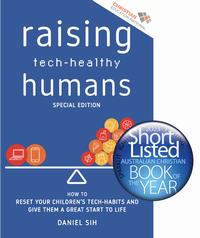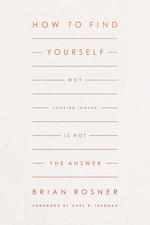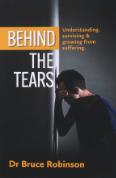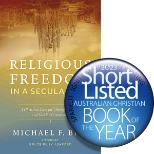Book Reviews
Book Review: Raising Tech-Healthy Humans
- Details
- Written by: Mark Simon
 Raising Tech-Healthy Humans
Raising Tech-Healthy Humans
DANIEL SIH
Publish Central, 2023
REVIEWED BY MARK SIMON
Daniel Sih’s book for parents on shaping the technology habits of their children is just what it claims to be – helpful guidance for parents grappling with technology usage in the modern world. Every parent I know grapples with this area. Countless studies and articles highlight the potential dangers of excessive technology use by children (and adults), and Sih includes brief highlights of some potential harms. So the need for guidance in this area is clear, and Sih serves up a range of practical strategies underpinned by a foundational principle: parenting is about raising adults, not children. Therefore, “the role of a parent is to love, mentor and equip their children with the physical, emotional and psychological experiences they need to become adults.” (p.7) The strategies, perspectives and reflection questions he presents all contribute to a parent’s ability to raise tech-healthy adults, not just to minimise arguments about screen time.
A brief chapter on brain development and function highlights the reasons children so easily get addicted to technology (it engages the ‘downstairs brain’ – impulsive, emotional, fight/flight responses), and introduces a distinction between passive and interactive media. Passive media (such as TV and movies) has been around for decades, but more recently the proliferation of interactive media (such as video gaming and social media) encourages users to ‘lean-forward’ to engage with it, and overstimulates the downstairs brain, making it the more problematic form of technology for healthy brain development.
The core of the book is a framework based on the acronym ‘Starter’. Start with self; Take it slowly; Age appropriateness; Regular talk; Tech-healthy rhythms; Encourage adventures; Rely on others. For each of these principles, Sih combines research and insights with practical suggestions. The book is a short and easy read – perfect for time-poor, technology-saturated parents. It includes an appendix ‘100 Fun Non-Screen Activities to do with Kids’ – which reminds us all that the best things in life are free (teddy bear picnics, dress-ups, board games, exercising together, music, water fights…)
One interesting feature of the book as a short-listed finalist in the Australian Christian Book of the Year Awards is that it doesn’t present any explicitly Christian perspectives on technology usage in the family. There are plenty of implicit priorities that Christian families would affirm (such as mentoring, and mutual accountability), but the book got me wondering whether parenting in a Christian context adds any distinctive dynamics or goals into the mix.
The book is also best suited to parents of younger children and pre-teens, since it acknowledges the capacity to impact or radically change course with teenagers who have already become set in unhealthy habits requires a different approach. Despite these minor quibbles, there is much benefit to be gained by readers of Sih’s book (not just parents, but anyone who uses technology).
Rev Dr Mark Simon is Lecturer in New Testament and Research Associate at Ridley College, and minister of St Luke’s Vermont.
Book Review: How to Find Yourself: Why looking inwards is not the answer
- Details
- Written by: Karen Hale
 How to Find Yourself: Why looking inwards is not the answer
How to Find Yourself: Why looking inwards is not the answer
REV DR BRIAN S. ROSNER
Crossway, 2022
REVIEWED BY KAREN HALE
In his previous book Known by God A biblical theology of personal identity (2017) Brian Rosner (Principal, Ridley College) outlines a compelling argument for our identity being directly linked to being known by God. This latest book is a more accessible account exploring our identity and the question ‘Who am I? In the west the answer to this question is solved by looking inward. Rosner critiques this way of working out our identity and explores the many short comings of this view. He then seeks to provide an alternative of seeing our identity not primarily from within but by looking upwards to God. This view of looking inward is called expressive individualism. It stresses that if you want to know yourself and be happy then you need to look inward. Personal freedom is prized above all else and we should celebrate everyone’s quest for self-expression. The positives of this view are briefly outlined by Rosner before addressing a thoughtful critique.
The question of identity is not new but the markers that we use to express our identity have changed significantly over the last 50 years. Today we use fewer identity markers to describe who we are. Rosner challenges us to ask 5 important questions of expressive individualism. Does it help us deal with suffering, our pride, the poor and weak, injustice and our happiness. Rosner argues that this way of finding our identity is both fragile and faulty.
By looking at some ancient Biblical texts Brian Rosner explores how we have seen the fragility and faults of humans in seeking to look within to define their identity. In the story of Adam and Eve we find humans thinking they can work out their own path and that they know best. This has terrible consequences, and it is only in looking at Jesus that we finally see a human who is tempted to trust themselves and yet trusts God. Even though today we are told to look inward, Rosner rightly identifies that this is not the full view. We have never been more obsessed with looking around us. Through social media, in particular, we compare and contrast ourselves to everyone else. Rosner suggests that the missing piece we are yearning for is looking upwards. True identity is beyond us. He suggests that we are a social story telling beings that want to worship. From when we are babies to the end of life we live in society and are shaped by all the relationships that we have. To know yourself you need to be known. Known by others but more importantly known by God.
Rosner contends that today the narrative that we inhabit is secular materialism. Historically this has come from the enlightenment, a story of progress, freedom from the dark past. We then had the sexual revolution, a story of freedom for pleasure. Now we see the story of consumerism, we are what we buy. This seems to tap into financial security and enjoyment. All these stories have failed us, as they do not take seriously the impact of personal freedoms nor the capacity of humans to do harm. There has been some acknowledgement of these pitfalls and so another story has emerged that highlights social justice. This is a strong voice at present. It is a very black and white view of social justice and fails to take into account the complexity of many issues.
In contrast to secular materialism Brian Rosner offers a positive way forward. We are part of a bigger story, God’s story, which is particularly seen in Jesus’ story. He then asks the same questions of this view. Can this help us with suffering, our pride, the poor and weak, injustice and happiness. We don’t just believe God’s story we inhabit this story.
The final part of the book looks at how to live within this story. It is a paradox that you are told to lose yourself to be able to find yourself. We don’t look in, but to Christ to truly find ourselves. We are encouraged to trust in Jesus and to immerse ourselves in his story, a story with love at the centre.
I highly commend this book as it seeks to help us engage with the complex issue of our identity. In a world that currently has fewer identity markers and yet espouses greater freedom that does not seem to deliver. Identity crisis seems to be occurring at every age today from children to the elderly. The story we have been sold of expressive individualism doesn’t seem to be delivering on the freedoms it seems to promise. Instead, people are more confused than ever. Brian Rosner provides a compelling case for seeing our identity within God’s story. The story of the good news of Jesus. It is a bigger story beyond ourselves but one in which we get to live. We are part of this narrative, and it is a story that is rooted in love. To be truly known and loved by God gives us an identity that is able to withstand the complexities of life.
Karen Hale is Teacher of Religious Education and Science at Ivanhoe Girls’ Grammar School.
Book Review: The Future is Bivocational
- Details
- Written by: Angus Monro
The Future is Bivocational
Andrew Hamilton
Arkhouse Press 2022
Reviewed by Rev Angus Monro
Andrew Hamilton wants to goad, encourage and guide pastors and church-planters to broaden their horizons beyond the standard “professional minister” model, and is convinced that bivocationality needs to become normal. So, this book – shortlisted for SparkLit’s 2023 Christian Book of the Year - is designed for you if you are:
- considering a future in pastoral ministry or church- planting
- struggling to connect meaningfully with your flock’s everyday experiences
- wanting to radically deepen your community engagement
- looking for a way to circumvent that inevitable conversation-stopper (“I’m a minister”)
- desiring your members to take more ministry
- operating bivocationally already but struggling to make it work
- or in a financially struggling parish.
Book Review Behind the Tears
- Details
- Written by: Michelle Monro
 Behind the Tears: Understanding, Surviving and Growing from Suffering
Behind the Tears: Understanding, Surviving and Growing from Suffering
Dr Bruce Robinson
Macsis Publishing, 2023
Reviewed by Michelle Monro
“Behind the Tears” is a book for those who are suffering, have suffered and are caring for those who suffer… in other words, for all of us.
If the reader is looking for a rich theological exploration of theodicy; or a radically transformative and perfectly argued perspective on godly suffering, this book should not be your first port of call. Dr Bruce Robinson is a medical doctor, not a theologian, and he readily admits that there is a wealth of other resources that address the question of suffering from an academic viewpoint.
Yet this is where the book’s value is to be found. Not only has the author spent many years journeying professionally beside those who suffer, Dr Robinson has personally experienced pain and loss on many different levels. The breadth and depth of his experience enable Dr Robinson to write on the topic of suffering with compassionate clarity.
Book Review: Religious Freedom in a Secular Age
- Details
- Written by: Michael Stead
 Religious Freedom in a Secular Age
Religious Freedom in a Secular Age
Rev Dr Michael F, Bird
Zondervan, 2022
Reviewed by Bp Michael Stead
Religious Freedom has become a lightning rod of controversy in many Western societies, over whether and how religious freedom needs to be limited in order to protect the rights and freedoms of others, especially the LGBTQI+ community. Bird’s book Religious Freedom in a Secular Age was written largely between 2016 and 2020, at a time when both Australia and the wider world were increasingly embroiled in political conflicts about this, arising from the intersections of religion, government, the public square and personal belief. Bird proposes a way forward that challenges those on the political left who are antagonistic to religion freedom, and those on the political right who seek to weaponise it.
Chapters one and two seek to give a positive argument for secularism, and to distinguish this from militant secularism. Bird argues that secularism is a “post- Christendom political settlement concerned with negotiating space for religious beliefs, diverse beliefs and unbelief in a society no longer dominated by a single homogeneous religious worldview.” (15). Secularism arose out of both the Reformation and the Enlightenment, emerging as the best way to ensure religious freedom in nation states made up of diverse religious adherents living in proximity to each other, set within the framework of fresh philosophies of political rights and freedoms. Bird argues that “secularism with the separation of church and state is a genuinely noble way to carry Christianity forward in a free, democratic and pluralistic environment” (54). Bird contrasts this to militant secularism, which seeks to both to remove religion from the public square and to subject religions to regulation by the state. Secularism is based on state neutrality to religion; militant secularism seeks to neutralise religion
Chapters three, four and five collectively make a positive case for religious freedom. Bird argues that Christians should not pursue a civil religion (such as Christian Nationalism) nor should they accept the imposition of a civic totalism driven by progressive authoritarianism, but instead pursue a confident pluralism. Confident pluralism is Bird’s articulation of classic liberal pluralism, in which individuals and groups have liberty to live and act in according with their own values, and the state should only limit this liberty where necessary to protect the freedoms and rights of others. Freedom of religion is critical in this, because it is the litmus test of overall freedom in society and overall human rights. Bird argues that “the society that ensures the free exercise of religion is more likely to uphold the rights of those who are vulnerable, marginalised, and despised for being ‘other’” (114).
Chapter six and seven propose a strategy for maintaining a Christian witness in a post-Christian society. Bird briefly canvasses other possible responses (political theocracy, living as “Christians in exile”, the “Benedict Option” and “faithful presence”), before articulating his own proposal, “the Thessalonian Strategy”. Bird argues that, like the church in Thessalonica described in Acts 17, we need to turn the world upside down by a counter-cultural living out of the gospel, while holding out a more compelling worldview that Jesus, not Caesar, is Lord. As applied to our modern secular context, “the Thessalonian strategy is a two-pronged approach. First, positively, we must champion confident pluralism as a sociopolitical philosophy, demonstrate community in action, love our neighbours, and live in such a way that those who hate us cannot give a reason for their hatred. Second, negatively, we must challenge the new legal structures being erected around us, expose the hypocrisies and prejudices of those who claim to be committed to tolerance, confront incursions into religious liberty, and disrupt the secular narrative that religion is bad for social fabric.” (131) We should work together in the public square with Christians across the denominational spectrum, and with other faith groups as well. We need to be apologists who defend not only our own beliefs but also the freedom of all faiths by articulating the case for a confident pluralism and advocating for a fair secularism.
This book is a very helpful and eminently readable account of the basis of, and argument for, religious freedom in secular liberal democracies. It is not, and does not seek to be, a work of political theology. Bird’s articulation of the “Thessalonian Strategy” is not the only possible way that Christians could seek to apply biblical principles to respond in the modern secular age, but in my view Bird’s proposal is a good option for our current context. I commend it warmly.
Bishop Dr Michael Stead is the Anglican Bishop of South Sydney and Chair of Freedom for Faith.
